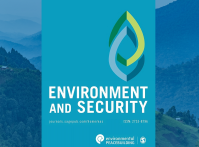-
Opportunity Costs: Evidence Suggests Variability, Not Scarcity, Primary Driver of Water Conflict
September 2, 2014 By Cullen Hendrix
Nearly 1 billion people lack reliable access to clean drinking water today. A report by the Water Resources Group projects that by 2030 annual global freshwater needs will reach 6.9 trillion cubic meters – 64 percent more than the existing accessible, reliable, and sustainable supply. This forecast, while alarming, likely understates the magnitude of tomorrow’s water challenge, as it does not account for the impacts of climate change.
While the Intergovernmental Panel on Climate Change (IPCC) forecasts an increase in total precipitation at the global level, regional patterns will vary significantly. Rainfall is projected to decline by more than 20 percent across North Africa, the Middle East, central Mexico, Central America, the Caribbean, Southern Africa, the eastern Amazon basin, and western Australia. The IPCC also forecasts a 90 percent likelihood that rainfall variability will increase, leading not only to more numerous dry spells, but also more extreme precipitation events and flooding.
Water’s critical role in the survival of human life, combined with imminent changes in its relative abundance, has understandably generated concern that it will be a cause of future conflict. The prospect of conflict over water is most clear in river basins where surface freshwater is shared between two or more states. In these cases, water constitutes a common pool resource whose consumption is rival: Uganda’s increasing consumption of Nile waters necessarily leaves downstream countries like Egypt and Sudan with less.
But contrary to popular belief, a new study by Colleen Devlin and I finds that water variability, rather than scarcity, may be the biggest climatic driver of interstate conflict.
Trends and Triggers
Devlin and I tested a range of water changes and their effects on conflict outcomes at the international level. Pushing beyond simple theories about resource-based conflict, we tested changing rainfall mean levels, variability, and acute scarcity (when pairs of countries face below-mean rainfall in a given year).
Variability complicates the creation of contracts governing shared use, making conflict more likely
Importantly, this research distinguishes between trends – longer-term mean states that may affect the baseline probability of conflict – and triggers – acute scarcity or abundance, that may affect the probability of conflict in the short run. It also explores how climatic factors may affect bargaining between states more generally, as opposed to just those interactions taking place over shared resources.
We assessed whether rainfall scarcity has different effects at different time scales. For example, while over the long term more scarce rainfall may be associated with greater probability of conflict due to increasing resource strain, over the short term acute scarcity should have a pacifying effect due to states’ attention being diverted to addressing the economic and social effects of below-average rainfall.
The same model yields the expectation that conflict will be more likely in pairs of countries characterized by higher variation in rainfall. Implicitly or explicitly, states form bargains over co-management of shared water resources. When precipitation in these countries is more variable, their withdrawal needs from the shared basin are as well. This variability complicates the creation of contracts governing shared use, making conflict more likely.
Guns vs. Butter
Our findings are consistent with theoretical expectations.
First, precipitation variability is more strongly associated with the outbreak of conflict, operationalized as militarized interstate disputes – threats, displays of or uses of military force, short of war – than mean levels of rainfall. We find consistent evidence that variability in rainfall is associated with more conflict.
Opportunity costs to interstate conflict increase with acute water scarcity
Second, pairs of states which are experiencing acute water scarcity are less, not more, likely to enter into disputes. This finding is curious when viewed through the perspective of Malthusian, dog-eat-dog resource competition, but makes more sense when viewed through the prism of opportunity cost.
Acute water scarcity and higher temperatures seem to lead to overall economic contraction, with particularly severe impacts on the agricultural and subsistence sectors. Demand for state resources, in the form of drought response activities such as emergency feeding programs and the provision of crop insurance, increases while state revenues decrease. To wit, the U.S. government budgeted $18.8 billion dollars to agricultural relief programs alone in 2012, part of a total disaster relief appropriation of $34.2 billion in FY 2012.Opportunity cost is essentially the cost you pay for not doing something with the resources you might use during conflict – the classic guns vs. butter tradeoff. Going to war is costly, both in terms of “blood and treasure” and also the economic and social losses stemming from diversion of productive resources into fighting.
Opportunity costs to interstate conflict thus increase with acute water scarcity. As opportunity costs increase for both countries, the range of outcomes both states prefer to fighting increases, making conflict less likely.
Time for the IPCC to Take on State Conflict?
Last month, a World Bank working paper by Shlomi Dinar, David Katz, Lucia De Stefano, and Brian Blakespoor reported that, by and large, rainfall variability was associated with greater international cooperation over shared rivers – though in basins with extreme variability, cooperation tended to wane.
Climatic conditions have clear impacts for interstate conflict and cooperation
Though our findings are somewhat in tension with theirs, they both suggest that growing attention to water scarcity should be accompanied by a focus on variability. In particular, variability plays a role apart from an increase in extreme, acute climatic events such as floods and droughts – short-term triggers that may affect the probability of conflict in a given year.
These results suggest those studying the climate-conflict nexus should move past Malthusian narratives of resource competition and think more generally about how climatic conditions affect the relative costs of waging war. In this sense, climate can be understood to affect conflicts which are in no way “about” resource scarcity.
Finally, these findings add to the mounting evidence that climatic conditions have clear impacts for interstate conflict and cooperation, a topic on which the most recent IPCC report is mum. In the absence of rigorous analysis to inform planning, policy makers are likely to fill the void with dramatic, but unsubstantiated, conjectures. We hope our analysis will push the discussion toward more closely aligning the modeling of human impacts with our understanding of the physical impacts of climate change.
Cullen Hendrix is an assistant professor at the Josef Korbel School of International Studies at the University of Denver and a non-resident senior fellow at the Peterson Institute for International Economics.
Sources: Center for American Progress, Intergovernmental Panel on Climate Change, McKinsey and Company, Political Geography, World Bank.
Photo Credit: A water point in Juba, South Sudan, May 2014, courtesy of Kieran Doherty/Oxfam.
 A Publication of the Stimson Center.
A Publication of the Stimson Center.






